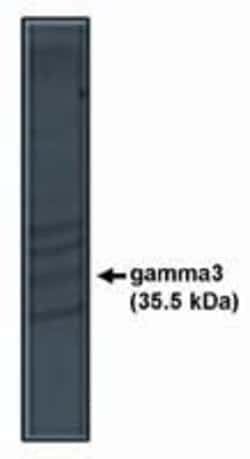Promotional price valid on web orders only. Your contract pricing may differ. Interested in signing up for a dedicated account number?
Learn More
Learn More
Invitrogen™ CACNG3 Polyclonal Antibody
Rabbit Polyclonal Antibody
Supplier: Invitrogen™ PA112674
Description
A suggested positive control for this product is rat brain lysate.
Calcium Channel gamma-3 is a member of voltage dependent calcium channels (VDCCs) which allows neurons to tailor calcium signaling to functionally discrete cellular regions. Although N-Type VDCCs exist before birth which is consistent with a role in migration, most N-Type VDCCs subunit expression is postnatal, and important in the genesis of synaptic transmission in discrete hippocampal fields. Calcium Channel gamma-3 is a type I transmembrane AMPA receptor regulatory protein (TARP). TARPs regulate both trafficking and channel gating of the AMPA receptors. Further, Calcium Channel gamma-3 is part of a functionally diverse eight-member protein subfamily of the PMP-22/EMP/MP20 family. Calcium Channel gamma-3 gene dysfunction is a susceptibility locus for childhood absence epilepsy.
Specifications
| CACNG3 | |
| Polyclonal | |
| PBS with 0.08% sodium azide | |
| O60359 | |
| Cacng3 | |
| Synthetic peptide, conjugated to KLH, corresponding to the rat calcium channel gamma3 subunit. | |
| 100 μg | |
| Primary | |
| Human | |
| Antibody | |
| IgG |
| Western Blot | |
| Unconjugated | |
| Cacng3 | |
| Cacng3; CACNLB3; calcium channel, voltage-dependent, gamma subunit 3; calcium voltage-gated channel auxiliary subunit gamma 3; CaVgamma3; neuronal voltage-gated calcium channel gamma-3 subunit; TARP gamma-3; transmembrane AMPAR regulatory protein gamma-3; Voltage-dependent calcium channel gamma-3 subunit; voltage-gated calcium channel gamma subunit | |
| Rabbit | |
| Ammonium Sulfate Precipitation | |
| RUO | |
| 10368 | |
| -20°C, Avoid Freeze/Thaw Cycles | |
| Liquid |
Product Content Correction
Your input is important to us. Please complete this form to provide feedback related to the content on this product.
Product Title
Spot an opportunity for improvement?Share a Content Correction
